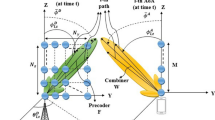Abstract
Beamforming algorithms are designed for generating main beams in the direction of interest and place nulls in the direction of interferences. Adaptive beamforming can be achieved by various optimization criteria. The criteria for an efficient design of algorithm is the speed of convergence, deeper null placement, better signal to noise ratio, and robustness. Motivated by the reduction in the computational complexity a new adaptive beamforming algorithm based on variable step size is proposed in this paper called sign variable step size LMS algorithm. The proposed algorithm is applied to the uniform linear array antenna. Simulation results show that it gives a better null placement in the direction of interference and the signal to noise ratio is improved upon the existing algorithms with less computational complexity.











Similar content being viewed by others
References
Chopra R, Lakhmani R (2017) Design and comparative evaluation of antenna array performance using non blind LMS beamforming algorithms. 2017 Progress in electromagnetics research symposium-fall (PIERS-FALL). IEEE, Singapore, pp 1827–1834
Rao AP, Sarma NVSN (2014) Adaptive beamforming algorithms for smart antenna systems. Methods 4(8):10–11
Razia S, Hossain T, Matin MA (2012) Performance analysis of adaptive beamforming algorithm for smart antenna system. In: 2012 International conference on informatics. Electronics & vision (ICIEV). IEEE, Dhaka, pp 946–949
Noordin NH, Khalidin Z (2014) Beamforming algorithms for adaptive array antenna. In: 2014 2nd International conference on electronic design (ICED). IEEE, Penang, pp 5–9
Rao AP, Sarma NVSN (2015) Performance analysis of kernel based adaptive beamforming for smart antenna systems. In: IEEE MTT-S international microwave and RF conference 2014, IMaRC 2014—collocated with intemational symposium microwaves, ISM 2014, no. 3, pp 262–265
Aghdam SA, Bagby J, Pla RJ (2016) Adaptive antenna array beamforming using variable-step-size normalized least mean square. In: 2016 17th international symposium antenna technology and applied electromagnetics, pp 1–5
Yong-jiang S, Dong-dong Q, Jia-ren R, Peng Z, Becerra DR (2012) Research on adaptive beamforming algorithm. In: 2012 International conference on image analysis and signal processing. IEEE, Hangzhou, pp 1–3
Gross FB (2005) Smart antennas for wireless communications with MATLAB. McGraw-Hill, New York
Jeripotula Praneet Raj, Rajendra Naik B (2018) Performance analysis of adaptive beamforming algorithms. In: Proceedings of the 2018 international conference on circuits and systems in digital enterprise technology (ICCSDET), pp 838–841
Jeripotula PR, Kumar CA, Naik BR (2019) Modified leaky LMS algorithm for adaptive beamforming. Int J Eng Appl Manag Sci Parad 54(3):8
Aghdam SA, Bagby J, Pla RJ (2016) Adaptive antenna array beamforming using variable-step-size normalized least mean square. In: 2016 17th international symposium on antenna technology and applied electromagnetics (ANTEM). IEEE
Balanis CA (2005) Antenna theory, vol 3rd. Wiley, New York
Shubair RM, Hakam A (2013) Adaptive beamforming using variable step-size LMS algorithm with novel ULA array configuration. In: International conference on communication technology proceedings. ICCT, pp 650–654
Thapa P, Jeong MA, Lee SR (2015) Performance analysis of LMS adaptive beam forming algorithms for smart antennas. Information 18(10):4175–4181
Sinha R, Choubey A, Mahto SK (2015) A novel and efficient hybrid least mean square (HLMS) adaptive algorithm for system identification. In: IntelliSys 2015—proceedings of the SAI intelligent systems conference, pp 894–897
Hakam A, Shubair RM, and Salahat E (2013) Enhanced DOA estimation algorithms using MVDR and MUSIC. In: Proceedings of the 2013 international conference on current trends in information technology CTIT 2013, no. 4, pp 172—176
Dasgupta S, Johnson CR, Baksho AM (1990) Sign-sign LMS convergence with independent stochastic inputs. IEEE Trans Inf Theory 36(1):197–201
Acknowledgements
This work is sponsored by Council of Scientific and Industrial Research (CSIR), New Delhi, India under Senior Research Fellowship scheme (CSIR-SRF).
Author information
Authors and Affiliations
Corresponding author
Rights and permissions
About this article
Cite this article
Jeripotula, P.R., Kumar, C.A. & Naik, B.R. A novel sign variable step size LMS (SiVSS-LMS) algorithm for adaptive beamforming. CSIT 8, 377–384 (2020). https://doi.org/10.1007/s40012-020-00313-4
Received:
Accepted:
Published:
Issue Date:
DOI: https://doi.org/10.1007/s40012-020-00313-4




